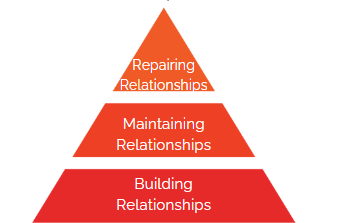Restorative Justice
Relational Triangle
The Volare Restorative Justice (RJ) team is dedicated to understanding the unique needs of survivors and ensuring the restorative justice process supports their healing journey.
Volare’s RJ program takes a compassionate, holistic approach to healing. It prioritizes the survivor’s needs, not just by creating a safety plan, but by empowering survivors to shape their own healing outside the traditional criminal justice system. This personalized process is carried out through a series of conversations that encourage self-reflection and growth.
The main objectives of the program are:
Repairing harm
Addressing survivors' needs
Rebuilding community relationships
These goals help survivors heal and restore balance within their communities. The program emphasizes community support, creatin
Ig a network of care that surrounds the survivor, ensuring they’re not healing alone.
Volare’s RJ Relational Triangle
The program focuses on three core elements:
Repairing Relationships
Maintaining Relationships
Building Relationships
These principles address the full spectrum of connections—both past and present—helping survivors reconnect with themselves and their communities.
Key Techniques for Supporting Survivors
Narrative Therapy (Restorative Conversations)
This technique helps survivors separate themselves from their challenges, allowing them to see their experiences as part of their journey, rather than defining who they are. By reframing their story, survivors regain control over their healing, recognize their strengths, and move forward with a renewed sense of agency.Charting
Charting helps track and visualize the survivor’s progress, marking important milestones in their journey. It’s a tool for clarity and reflection.Consensus
Achieving consensus among everyone involved ensures equity and a shared understanding. When all voices are heard and there’s agreement on how to move forward, it strengthens everyone’s commitment to the survivor’s healing process.Legacy Capsule
This is a symbolic gesture that honors the memories of lost loved ones. By collecting meaningful items—such as photos or letters—survivors create a space for grief and remembrance. The informal ceremony surrounding the capsule helps survivors celebrate the importance of their connections while acknowledging their loss.Circles
Community circles bring survivors and their community members (or appointed individuals) together for open, supportive dialogue. This creates shared responsibility for healing, emphasizing collective action and helping survivors feel surrounded by care and understanding.Thematic Awareness/Risk Assessment
This technique identifies recurring patterns and potential risks in the survivor’s healing journey. It ensures that safety and well-being are prioritized, preventing setbacks or re-traumatization. By identifying risks early, facilitators can help guide future steps to reduce harm and maintain progress.
The Overall Goal
The core goal of RJ is to help survivors visualize a path forward by shifting perspectives and crafting a new narrative that aligns with their healing and goals. The flexibility of the RJ team, with its variety of approaches, ensures that the survivor’s journey is both personalized and empowering.
Want help? Contact us today.

